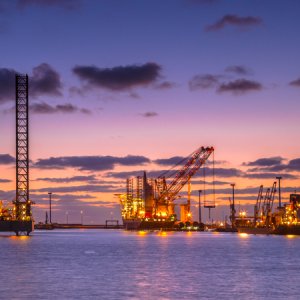Blazing a Production Trail in Shallow Waters

STORY INLINE POST
Q: Fieldwood Energy has increased Block 4 estimated reserves from 68MMb to 455MMb. How was that achieved?
A: Fieldwood Energy had no involvement in the original estimates but, from the beginning, we believed the figures to be low. The revised 455MMb estimate includes only oil, not gas, and we believe the recoverable reserves to be much higher, around 650MMb. The estimate is a result of drilling, completing and testing on only two wells in Pokoch and Ichalkil; there will be more to come. We have both Jurassic and Cretaceous reservoirs and we think the field will be huge. The company is on schedule to hit first production in 2020 while maximum production, which CNH estimates at 104Mb/d, should occur in 2026. At the same time, we expect gas production to hit 140MMcf/d.
Fieldwood was able to increase the reserve estimates almost sevenfold because the rock properties and reservoir characteristics were better quality in the wells we drilled than those found in the initial PEMEX wells. We moved away between 4,000ft and 5000ft from PEMEX’s wells and found a thicker reservoir. Second, we did not find a water level in the Jurassic or Cretaceous reservoirs, so the extent of the area is larger than first thought. Third, on the Ichalkil field, the company found that the Jurassic reservoir extends further east than PEMEX had realized. Fourth, because we were able to conduct extensive production tests for weeks at a time, we have determined the most efficient flow rate for these wells. We now know the real deliverability in terms of production volumes. PEMEX’s drill tests had been only hours and they did not use an ESP (Electro-Submersible Pump). While overall reserve size and recoverability is important, the way those reserves are developed is the key. It is the recovery amount per well where Fieldwood and the Mexican government will profit.
Platforms on this site are due this summer and the drilling rigs are scheduled to begin drilling later this year. The large size of these fields means there will be surprises and changes, both positive and negative, as they are developed. Despite this, Fieldwood Energy is confident that the US$500 million investment to hit first production and the speed with which we are progressing makes this field very attractive. We already have the capital in place to fund the entire development.
Q: How will Fieldwood get to first production in Pokoch and Ichalkil?
A: Phase 1 of our development plan includes installing platforms: one at Pokoch and the other at Ichalkil. The jacket will be set before other wells are drilled. Three or four additional wells are likely in Ichalkil and one or two in Pokoch during the first Phase.
The company’s plan also involves laying pipeline from our block to an unused PEMEX platform where we will transfer custody of the oil and gas from Fieldwood to PEMEX. The agreement for this transfer of custody point is being finalized and is the most efficient way to begin production quickly. We are three to four months behind on this pipeline project because the approval of the development plan was delayed. Our major contracts have been tentatively awarded for the first phase but the names of these companies will not be released until the project is finalized.
Q: How will Fieldwood guarantee the correct measurement of well production?
A: Fieldwood will install meters for the measurement at the transfer of custody point. Metering is a big issue in Mexico because it was not a common practice before; until recently there was only one operator. But our company possesses the technology to carry out metering simply and with accuracy; it is part of our everyday practice in the US.
We will have to agree with PEMEX on the meter readings at the custody transfer point and PEMEX will then have the option to transfer or buy the production. We have discussed entering into a contract with Trafigura, which is responsible for marketing the government’s production.
Q: From where will Fieldwood control operations on Block 4?
A: We have a shore facility in Ciudad del Carmen that we have leased on a long-term basis. Most of the technical work is being done in Houston. We also work closely with our partner, PetroBal, and its technical team in Mexico City, where we also have an office for financial and government relations activities.
In Ciudad del Carmen, 25 personnel, including drilling engineers, logistics directors and safety managers, will be on site during the drilling stage.
Q: What are the next steps for Fieldwood Energy in Mexico?
A: Our Phase 2 plan is to control our volume in Ichalkil and Pokoch by building a pipeline to the Dos Bocas terminal between 2021 and 2023. But our current Mexican project is large and should rival the size of our US projects so we expect to be kept busy for the next few years. Fieldwood has now had a footprint in Mexico for three and a half years and we have built a strong relationship with PetroBal. The company has established itself as a quality operator and would consider any production-sharing contract. If or when the bid rounds start again, we will certainly be involved.
Fieldwood Energy is an E&P company that focuses on offshore. Based in Houston, Texas, it is present in both the US and Mexico. In 2017, Fieldwood became the first US company in 75 years to drill an offshore well in Mexican territory.
























